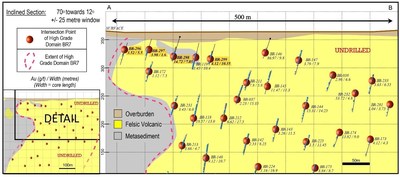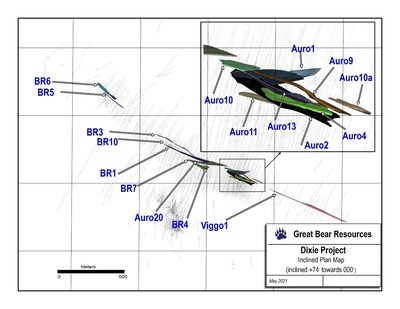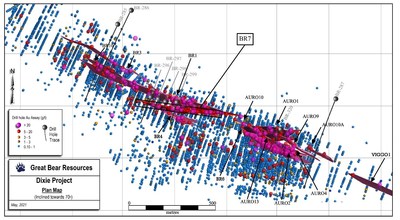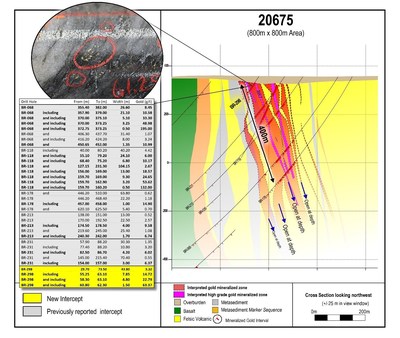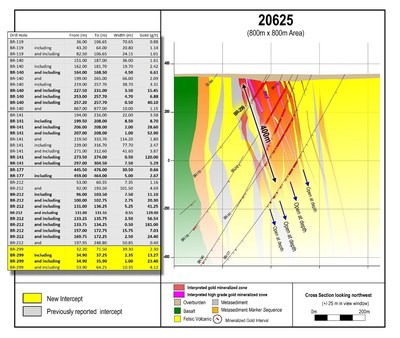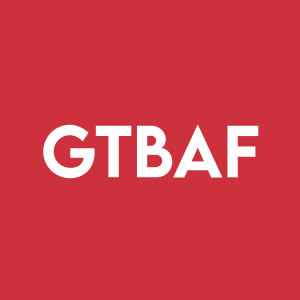Great Bear Provides First Detailed High-Grade Long Section, Drills 22.79 g/t Gold Over 4.80 metres from Bedrock Surface, and Reaches 300 Reported LP Fault Drill Holes
Great Bear Resources announced progress from its $45 million exploration program at the Dixie Project in Red Lake, Ontario. The company is focusing on 17 high-grade gold domains within the LP Fault zone, with detailed drill results now available. Highlights include BR-298, which reported 22.79 g/t gold over 4.80 meters, and BR-299 showing 13.27 g/t gold over 2.35 meters. The drill program aims to enhance mineral resource estimation and is on track for completion by year-end. The LP Fault zone remains open for further extension, promising strong exploration potential moving forward.
- Reported high-grade gold intersections, including BR-298 with 22.79 g/t gold over 4.80 meters.
- Continued exploration success with 300 drill holes released to date.
- Strong continuity of gold mineralization in the LP Fault zone, which is open for extension in all directions.
- None.
TSX-V: GBR
VANCOUVER, BC, May 19, 2021 /PRNewswire/ - Great Bear Resources Ltd. (the "Company" or "Great Bear") (TSXV: GBR) (OTCQX: GTBAF) today reported results from its ongoing fully funded
Chris Taylor, President and CEO of Great Bear said, "We are now entering the final months of near-surface maiden mineral resource estimation drilling of the central LP Fault zone, and are modeling 17 distinct high-grade gold domains within the broader LP Fault gold mineralized system. For the first time, we provide a detailed long section of the upper portion of one of these high-grade domains, a summary of all drill results within that long section, and detailed maps of the high-grade domains within the broader LP Fault gold system."
Great Bear plans to release detailed high-grade and bulk tonnage domain information over the coming months. This news release includes the first of this information.
Table 1: All 28 drill holes that intersect the near-surface portion of high-grade domain BR7, along 500 metres of strike length. New results in italics (holes BR-296-299). Note that assay intervals from previously reported drill holes have been clipped to domain BR7.
Drill Hole | From (m) | To (m) | Width* (m) | Gold (g/t) |
BR-037 | 135.30 | 150.70 | 15.35 | 2.23 |
BR-038 | 81.20 | 87.80 | 6.60 | 2.96 |
BR-118 | 156.00 | 169.00 | 13.00 | 18.57 |
BR-119 | 46.60 | 57.00 | 10.40 | 1.45 |
BR-140 | 247.00 | 257.70 | 10.70 | 4.12 |
BR-142 | 231.00 | 239.30 | 8.25 | 2.53 |
BR-143 | 182.00 | 193.50 | 11.50 | 5.26 |
BR-144 | 130.00 | 144.30 | 14.25 | 15.31 |
BR-145 | 95.60 | 106.90 | 11.30 | 11.47 |
BR-146 | 35.75 | 45.55 | 9.80 | 86.97 |
BR-147 | 48.00 | 55.90 | 7.90 | 3.79 |
BR-172 | 84.00 | 91.50 | 7.50 | 1.12 |
BR-173 | 210.00 | 214.30 | 4.30 | 4.12 |
BR-174 | 207.00 | 216.00 | 9.00 | 13.82 |
BR-175 | 256.00 | 264.70 | 8.70 | 3.84 |
BR-211 | 99.80 | 105.60 | 5.80 | 7.80 |
BR-212 | 157.00 | 174.50 | 17.50 | 6.62 |
BR-213 | 240.30 | 245.00 | 4.70 | 3.66 |
BR-224 | 311.50 | 328.40 | 16.90 | 1.16 |
BR-225 | 231.75 | 243.20 | 11.45 | 1.50 |
BR-231 | 151.00 | 157.00 | 6.00 | 3.43 |
BR-232 | 106.20 | 111.00 | 4.80 | 53.72 |
BR-233 | 78.30 | 84.85 | 6.55 | 3.63 |
BR-281 | 170.25 | 174.00 | 3.75 | 1.04 |
BR-296 | 27.30 | 32.80 | 5.50 | 3.52 |
BR-297 | 31.00 | 32.60 | 1.60 | 3.98 |
BR-298 | 55.25 | 63.10 | 7.85 | 14.72 |
BR-299 | 53.90 | 64.25 | 10.35 | 4.12 |
* Widths are drill indicated core length, as insufficient drilling has been undertaken to determine true widths at this time. Average grades are calculated with un-capped gold assays, as insufficient drilling has been completed to determine capping levels for higher grade gold intercepts. Interval widths are calculated using a 0.10 g/t gold cut-off grade with up to 3 m of internal dilution of zero grade. |
Figures 1, 2, 3, 4 and 5 respectively show: 1) A detailed long section of high-grade domain "BR7", which is one of 17 high-grade domains currently being drilled, 2) a map of all high-grade domains within the LP Fault, 3) A more detailed map of the high-grade domains in the central LP Fault zone, including surrounding bulk tonnage style mineralization, and 4) two cross sections through high-grade domain BR7.
Table 1 provides all gold intercepts from BR7 shown in Figure 1. Table 2 provides all new gold assay results from the most recent LP Fault drilling.
With the 17 drill holes included in this release, Great Bear has released 300 LP Fault drill holes to date.
Highlights of Current Results
- New drill holes reported in this release intersected the LP Fault zone from approximately 20 to 500 metres vertical depth along 2.2 kilometres of strike length.
- Drill holes were located a) above previous drilling, in order to extend gold mineralization towards surface, and b) within 75 to 100 metre previously undrilled gaps in the zone.
- Two drill holes are step-ups that extend gold mineralization by more than 75 metres above previous drilling to the near-surface:
- BR-298 assayed 22.79 g/t gold over 4.80 metres from 58.30 to 63.10 metres downhole, within a broader mineralized interval assaying 3.32 g/t gold over 43.80 metres from 29.70 to 73.50 metres downhole.
- BR-299 assayed 13.27 g/t gold over 2.35 metres from 34.90 to 37.25 metres downhole, and 4.12 g/t gold over 10.35 metres from 53.90 to 64.25 metres downhole. The total mineralized interval was 2.30 g/t gold over 39.30 metres from 32.20 metres to 71.50 metres downhole.
- New bulk-tonnage type intercepts include:
- 3.07 g/t gold over 35.60 metres from 117.00 to 152.60 metres downhole in drill hole BR-320.
- 1.11 g/t gold over 91.60 metres from 349.50 to 441.10 metres downhole in drill hole BR-285.
- 1.00 g/t gold over 91.40 metres from 473.60 to 565.00 metres downhole in drill hole BR-286.
- Drill holes with multiple intervals of gold mineralization including both high-grade and bulk tonnage type results include:
- BR-276 which assayed 25.57 g/t gold over 2.50 metres from 233.50 to 236.00 metres downhole, and 4.10 g/t gold over 23.85 metres from 462.25 to 486.10 metres downhole, including a high-grade core of 68.40 g/t gold over 0.95 metres from 485.15 to 486.10 metres downhole.
Results continue to demonstrate excellent continuity of high-grade and bulk-tonnage gold mineralization. The LP Fault zone remains open to extension in all directions.
Table 2: Current drill results from the LP Fault. Results are arranged by drill section from southeast (top) to northwest (bottom).
Drill Hole | From (m) | To (m) | Width* (m) | Gold (g/t) | Section | |
BR-287 | 375.00 | 388.25 | 13.25 | 1.21 | 19825 | |
BR-320 | 47.00 | 48.00 | 1.00 | 8.59 | 20000 | |
and | 93.20 | 108.00 | 14.80 | 1.66 | ||
including | 96.35 | 97.50 | 1.15 | 15.50 | ||
and | 117.00 | 152.60 | 35.60 | 3.07 | ||
including | 118.00 | 120.70 | 2.70 | 6.64 | ||
and including | 130.50 | 133.00 | 2.50 | 4.77 | ||
and including | 138.90 | 152.60 | 13.70 | 5.18 | ||
and including | 138.90 | 139.50 | 0.60 | 24.40 | ||
and including | 150.45 | 150.95 | 0.50 | 53.50 | ||
BR-299 | 32.20 | 71.50 | 39.30 | 2.30 | 20600 | |
including | 34.90 | 37.25 | 2.35 | 13.27 | ||
and including | 34.90 | 35.90 | 1.00 | 23.40 | ||
and including | 53.90 | 64.25 | 10.35 | 4.12 | ||
BR-298 | 29.70 | 73.50 | 43.80 | 3.32 | 20625 | |
including | 55.25 | 63.10 | 7.85 | 14.72 | ||
and including | 58.30 | 63.10 | 4.80 | 22.79 | ||
and including | 60.80 | 61.30 | 0.50 | 161.00 | ||
BR-297 | 31.00 | 50.10 | 19.10 | 0.99 | 20675 | |
including | 31.00 | 32.60 | 1.60 | 3.98 | ||
BR-296 | 27.30 | 51.50 | 24.20 | 1.39 | 20750 | |
including | 27.30 | 32.80 | 5.50 | 3.52 | ||
BR-286 | 473.60 | 565.00 | 91.40 | 1.00 | 21125 | |
including | 473.60 | 482.00 | 8.40 | 3.27 | ||
and including | 481.20 | 482.00 | 0.80 | 18.40 | ||
and including | 502.20 | 502.80 | 0.60 | 52.30 | ||
BR-285 | 349.50 | 441.10 | 91.60 | 1.11 | 21150 | |
including | 354.00 | 362.55 | 8.55 | 8.26 | ||
and including | 356.50 | 358.50 | 2.00 | 31.20 | ||
BR-277 | 517.25 | 521.00 | 3.75 | 0.82 | 21750 | |
including | 517.25 | 518.35 | 1.10 | 1.52 | ||
BR-263 | 585.50 | 591.50 | 6.00 | 1.06 | 21850 | |
including | 589.65 | 590.20 | 0.55 | 3.81 | ||
BR-264 | 548.50 | 580.20 | 31.70 | 1.48 | 21850 | |
including | 552.75 | 558.00 | 5.25 | 5.15 | ||
and including | 552.75 | 554.30 | 1.55 | 12.01 | ||
and including | 557.05 | 558.00 | 0.95 | 6.42 | ||
BR-265 | 420.85 | 421.40 | 0.55 | 5.64 | 21900 | |
and | 503.20 | 504.30 | 1.10 | 6.05 | ||
BR-302 | 356.00 | 368.50 | 12.50 | 2.47 | 21975 | |
including | 359.25 | 359.75 | 0.50 | 57.00 | ||
and | 421.20 | 430.00 | 8.80 | 1.13 | ||
BR-276 | 225.60 | 236.00 | 10.40 | 6.63 | 22000 | |
including | 233.50 | 236.00 | 2.50 | 25.57 | ||
and | 258.45 | 258.95 | 0.50 | 19.50 | ||
and | 311.85 | 316.00 | 4.15 | 2.19 | ||
including | 314.05 | 314.65 | 0.60 | 10.50 | ||
and | 389.60 | 396.75 | 7.15 | 5.85 | ||
including | 392.25 | 395.25 | 3.00 | 12.70 | ||
and | 462.25 | 486.10 | 23.85 | 4.10 | ||
including | 483.45 | 486.10 | 2.65 | 28.01 | ||
and including | 485.15 | 486.10 | 0.95 | 68.40 | ||
BR-278 | 212.00 | 213.00 | 1.00 | 5.84 | 22000 | |
and | 226.50 | 237.00 | 10.50 | 2.13 | ||
including | 232.80 | 233.30 | 0.50 | 41.80 | ||
BR-301 | 353.00 | 354.50 | 1.50 | 2.93 | 22000 | |
and | 560.55 | 561.10 | 0.55 | 3.49 | ||
BR-300 | 319.20 | 322.75 | 3.55 | 1.06 | 22025 | |
and | 468.30 | 471.30 | 3.00 | 1.03 |
* Widths are drill indicated core length, as insufficient drilling has been undertaken to determine true widths at this time. Average grades are calculated with un-capped gold assays, as insufficient drilling has been completed to determine capping levels for higher grade gold intercepts. Interval widths are calculated using a 0.10 g/t gold cut-off grade with up to 3 m of internal dilution of zero grade. |
About High-Grade Gold Domains and BR7
The 17 high-grade domains are structurally and geologically distinctive from the surrounding lower grade, bulk tonnage style gold mineralization. Together, they span a strike length of 4.2 kilometres and occur within eight larger stratigraphically controlled lower grade domains. They are characterized by high degrees of strain and/or transposed quartz vein zones following two distinct structural fabrics and transition from upper greenschist to lower amphibolite facies metamorphism. Gold in the high-grade domains is generally observed as free gold, is often transposed into, and overgrows the dominant structural fabrics, and is higher-grade on average than the surrounding bulk tonnage gold zones.
Domain BR7, presented in this news release, has a surface strike length of 620 metres and has been drilled to a depth of 500 metres (where it remains open to extension). BR7 is a high strain zone hosted within strongly altered (albite, biotite, +/- quartz veined) felsic volcanic rocks and occurs oblique to the dominant geological contacts. It has an average strike orientation of 270 degrees and dips 74 degrees to the north.
Drilling is planned to intersect the various high-grade domains at 40 – 50 metre spacing. Figure 1 demonstrates how drilling is nearing completion within the upper portions of domain "BR7", with few drill holes now required to provide the desired drill density for upcoming maiden resource estimation. Drilling is also nearing completion in the near-surface portions of all 17 high-grade domains along more than 4 kilometres of strike length of the central LP Fault. This drilling is expected to be completed from surface to an average of approximately 400 metres depth by year end.
Great Bear's progress can be followed using the Company's plan maps, long sections and cross sections, and through the VRIFY model posted at the Company's web site at www.greatbearresources.ca. All LP Fault drill hole highlighted assays, plus drill collar locations and orientations can also be downloaded at the Company's web site.
Drill collar location, azimuth and dip for drill holes included in this release are provided in the table below (UTM zone 15N, NAD 83):
Hole ID | Easting | Northing | Elevation | Length | Dip | Azimuth |
BR-263 | 456097 | 5635122 | 374 | 639 | -56 | 222 |
BR-264 | 456097 | 5635122 | 374 | 642 | -58 | 235 |
BR-265 | 455959 | 5635089 | 373 | 657 | -68 | 222 |
BR-276 | 455897 | 5635136 | 374 | 570 | -66 | 220 |
BR-277 | 456117 | 5635007 | 373 | 594 | -61 | 220 |
BR-278 | 455899 | 5635139 | 374 | 540 | -60 | 225 |
BR-285 | 456570 | 5634607 | 359 | 621 | -62 | 220 |
BR-286 | 456643 | 5634693 | 361 | 624 | -58 | 218 |
BR-287 | 457838 | 5634151 | 363 | 630 | -54 | 208 |
BR-296 | 456767 | 5634155 | 357 | 204 | -55 | 213 |
BR-297 | 456807 | 5634141 | 357 | 120 | -56 | 210 |
BR-298 | 456854 | 5634122 | 357 | 117 | -55 | 210 |
BR-299 | 456922 | 5634125 | 356 | 168 | -56 | 210 |
BR-300 | 455929 | 5635241 | 375 | 666 | -54 | 225 |
BR-301 | 455968 | 5635212 | 374 | 678 | -61 | 226 |
BR-302 | 455968 | 5635212 | 374 | 628 | -60 | 222 |
BR-320 | 457521 | 5633960 | 351 | 225 | -46 | 222 |
About the Dixie Project
The Dixie Project is
The Dixie Project hosts two principal styles of gold mineralization:
- High-grade gold in quartz veins and silica-sulphide replacement zones (Dixie Limb, Hinge and Arrow zones). Hosted by mafic volcanic rocks and localized near regional-scale D2 fold axes. These mineralization styles are also typical of the significant mined deposits of the Red Lake district.
- High-grade disseminated gold with broad moderate to lower grade envelopes (LP Fault). The LP Fault is a significant gold-hosting structure which has been seismically imaged to extend to 14 kilometres depth (Zeng and Calvert, 2006), and has been interpreted by Great Bear to have up to 18 kilometres of strike length on the Dixie property. High-grade gold mineralization is controlled by structural and geological contacts, and moderate to lower-grade disseminated gold surrounds and flanks the high-grade intervals. The dominant gold-hosting stratigraphy consists of felsic sediments and volcanic units.
About Great Bear
Great Bear Resources Ltd. is a well-financed gold exploration company managed by a team with a track record of success in mineral exploration. Great Bear is focused in the prolific Red Lake gold district in northwest Ontario, where the company controls over 330 km2 of highly prospective tenure across 5 projects: the flagship Dixie Project (
QA/QC and Core Sampling Protocols
Drill core is logged and sampled in a secure core storage facility located in Red Lake Ontario. Core samples from the program are cut in half, using a diamond cutting saw, and are sent to Activation Laboratories in Ontario, an accredited mineral analysis laboratory, for analysis. All samples are analysed for gold using standard Fire Assay-AA techniques. Samples returning over 10.0 g/t gold are analysed utilizing standard Fire Assay-Gravimetric methods. Pulps from approximately
Qualified Person and NI 43-101 Disclosure
Mr. R. Bob Singh, P.Geo, VP Exploration, and Ms. Andrea Diakow P.Geo, Exploration Manager for Great Bear are the Qualified Persons as defined by National Instrument 43-101 responsible for the accuracy of technical information contained in this news release.
ON BEHALF OF THE BOARD
"Chris Taylor"
Chris Taylor, President and CEO
Cautionary note regarding forward-looking statements
This release contains certain "forward looking statements" and certain "forward-looking information" as defined under applicable Canadian and U.S. securities laws. Forward-looking statements and information can generally be identified by the use of forward-looking terminology such as "may", "will", "should", "expect", "intend", "estimate", "anticipate", "believe", "continue", "plans" or similar terminology. The forward-looking information contained herein is provided for the purpose of assisting readers in understanding management's current expectations and plans relating to the future. Readers are cautioned that such information may not be appropriate for other purposes.
Forward-looking information are based on management of the parties' reasonable assumptions, estimates, expectations, analyses and opinions, which are based on such management's experience and perception of trends, current conditions and expected developments, and other factors that management believes are relevant and reasonable in the circumstances, but which may prove to be incorrect.
Such factors, among other things, include: impacts arising from the global disruption caused by the Covid-19 coronavirus outbreak, business integration risks; fluctuations in general macroeconomic conditions; fluctuations in securities markets; fluctuations in spot and forward prices of gold or certain other commodities; change in national and local government, legislation, taxation, controls, regulations and political or economic developments; risks and hazards associated with the business of mineral exploration, development and mining (including environmental hazards, industrial accidents, unusual or unexpected formations pressures, cave-ins and flooding); discrepancies between actual and estimated metallurgical recoveries; inability to obtain adequate insurance to cover risks and hazards; the presence of laws and regulations that may impose restrictions on mining; employee relations; relationships with and claims by local communities and indigenous populations; availability of increasing costs associated with mining inputs and labour; the speculative nature of mineral exploration and development (including the risks of obtaining necessary licenses, permits and approvals from government authorities); and title to properties.
Great Bear undertakes no obligation to update forward-looking information except as required by applicable law. Such forward-looking information represents management's best judgment based on information currently available. No forward-looking statement can be guaranteed and actual future results may vary materially. Accordingly, readers are advised not to place undue reliance on forward-looking statements or information.
![]() View original content to download multimedia:http://www.prnewswire.com/news-releases/great-bear-provides-first-detailed-high-grade-long-section-drills-22-79-gt-gold-over-4-80-metres-from-bedrock-surface-and-reaches-300-reported-lp-fault-drill-holes-301294641.html
View original content to download multimedia:http://www.prnewswire.com/news-releases/great-bear-provides-first-detailed-high-grade-long-section-drills-22-79-gt-gold-over-4-80-metres-from-bedrock-surface-and-reaches-300-reported-lp-fault-drill-holes-301294641.html
SOURCE Great Bear Resources Ltd.
FAQ
What are the recent drilling results from Great Bear Resources' Dixie Project?
What is the significance of the LP Fault zone for Great Bear Resources?
When is Great Bear Resources expected to complete its drilling program?
How many drill holes has Great Bear Resources completed to date?







